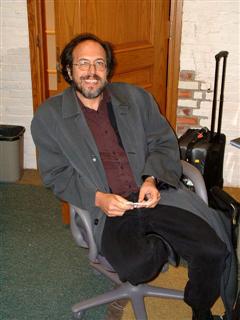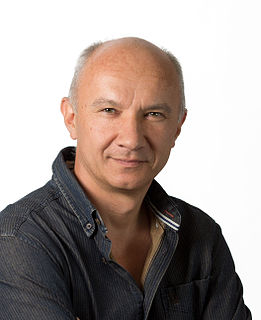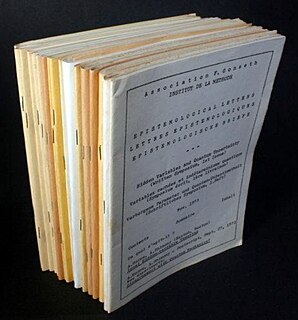David Elieser Deutsch is a British physicist at the University of Oxford. He is a Visiting Professor in the Department of Atomic and Laser Physics at the Centre for Quantum Computation (CQC) in the Clarendon Laboratory of the University of Oxford. He pioneered the field of quantum computation by formulating a description for a quantum Turing machine, as well as specifying an algorithm designed to run on a quantum computer. He has also proposed the use of entangled states and Bell's theorem for quantum key distribution and is a proponent of the many-worlds interpretation of quantum mechanics.

The many-worlds interpretation (MWI) is an interpretation of quantum mechanics that asserts that the universal wavefunction is objectively real, and that there is no wavefunction collapse. This implies that all possible outcomes of quantum measurements are physically realized in some "world" or universe. In contrast to some other interpretations, such as the Copenhagen interpretation, the evolution of reality as a whole in MWI is rigidly deterministic. Many-worlds is also referred to as the relative state formulation or the Everett interpretation, after the physicist Hugh Everett who first proposed it in 1957. The formulation was popularized and named many-worlds by Bryce DeWitt in the 1960s and 1970s.

The multiverse is a hypothetical group of multiple universes. Together, these universes comprise everything that exists: the entirety of space, time, matter, energy, information, and the physical laws and constants that describe them. The different universes within the multiverse are called "parallel universes", "other universes", or "alternate universes".
Reality is the sum or aggregate of all that is real or existent within a system, as opposed to that which is only imaginary. The term is also used to refer to the ontological status of things, indicating their existence. In physical terms, reality is the totality of a system, known and unknown. Philosophical questions about the nature of reality or existence or being are considered under the rubric of ontology, which is a major branch of metaphysics in the Western philosophical tradition. Ontological questions also feature in diverse branches of philosophy, including the philosophy of science, philosophy of religion, philosophy of mathematics, and philosophical logic. These include questions about whether only physical objects are real, whether reality is fundamentally immaterial, whether hypothetical unobservable entities posited by scientific theories exist, whether God exists, whether numbers and other abstract objects exist, and whether possible worlds exist.
An interpretation of quantum mechanics is an attempt to explain how the mathematical theory of quantum mechanics "corresponds" to reality. Although quantum mechanics has held up to rigorous and extremely precise tests in an extraordinarily broad range of experiments, there exist a number of contending schools of thought over their interpretation. These views on interpretation differ on such fundamental questions as whether quantum mechanics is deterministic or random, which elements of quantum mechanics can be considered "real", and what is the nature of measurement, among other matters.

Lee Smolin is an American theoretical physicist, a faculty member at the Perimeter Institute for Theoretical Physics, an adjunct professor of physics at the University of Waterloo and a member of the graduate faculty of the philosophy department at the University of Toronto. Smolin's 2006 book The Trouble with Physics criticized string theory as a viable scientific theory. He has made contributions to quantum gravity theory, in particular the approach known as loop quantum gravity. He advocates that the two primary approaches to quantum gravity, loop quantum gravity and string theory, can be reconciled as different aspects of the same underlying theory. His research interests also include cosmology, elementary particle theory, the foundations of quantum mechanics, and theoretical biology.

In the history of science, Laplace's demon was the first published articulation of causal or scientific determinism, by Pierre-Simon Laplace in 1814. According to determinism, if someone knows the precise location and momentum of every atom in the universe, their past and future values for any given time are entailed; they can be calculated from the laws of classical mechanics.
In physics and cosmology, digital physics is a collection of theoretical perspectives based on the premise that the universe is describable by information. It is a form of digital ontology about the physical reality. According to this theory, the universe can be conceived of as either the output of a deterministic or probabilistic computer program, a vast, digital computation device, or mathematically isomorphic to such a device.
Frank Jennings Tipler is an American mathematical physicist and cosmologist, holding a joint appointment in the Departments of Mathematics and Physics at Tulane University. Tipler has written books and papers on the Omega Point based on Pierre Teilhard de Chardin's religious ideas, which he claims is a mechanism for the resurrection of the dead. He is also known for his theories on the Tipler cylinder time machine. George Ellis has argued that his theories are largely pseudoscience.
Digital philosophy is a direction in philosophy and cosmology advocated by certain mathematicians and theoretical physicists, including: Edward Fredkin, Konrad Zuse, Stephen Wolfram, Rudy Rucker, Gregory Chaitin, Seth Lloyd. and Paola Zizzi.
In computer science and quantum physics, the Church–Turing–Deutsch principle is a stronger, physical form of the Church–Turing thesis formulated by David Deutsch in 1985. The principle states that a universal computing device can simulate every physical process.

Artur Konrad Ekert FRS is a British-Polish professor of quantum physics at the Mathematical Institute, University of Oxford, professorial fellow in quantum physics and cryptography at Merton College, Oxford, Lee Kong Chian Centennial Professor at the National University of Singapore and director of the Centre for Quantum Technologies (CQT). His research interests extend over most aspects of information processing in quantum-mechanical systems, with a focus on quantum communication and quantum computation. He is best known for important contributions to the field of quantum cryptography.

Parallel Worlds: A Journey Through Creation, Higher Dimensions, and the Future of the Cosmos is a popular science book by Michio Kaku first published in 2004.
There is a diversity of views that propose interpretations of quantum mechanics. They vary in how many physicists accept or reject them. An interpretation of quantum mechanics is a conceptual scheme that proposes to relate the mathematical formalism to the physical phenomena of interest. The present article is about those interpretations which, independently of their intrinsic value, remain today less known, or are simply less debated by the scientific community, for different reasons.
Everything is all that exists; the opposite of nothing, or its complement. It is the totality of things relevant to some subject matter. Without expressed or implied limits, it may refer to anything. The Universe is everything that exists theoretically, though a multiverse may exist according to theoretical cosmology predictions. It may refer to an anthropocentric worldview, or the sum of human experience, history, and the human condition in general. Every object and entity is a part of everything, including all physical bodies and in some cases all abstract objects.
An index list of articles about the philosophy of science.

The Beginning of Infinity: Explanations that Transform the World is a popular science book by the physicist David Deutsch first published in 2011.

Epistemological Letters was a hand-typed, mimeographed "underground" newsletter about quantum physics that was distributed to a private mailing list, described by the physicist John Clauser as a "quantum subculture", between 1973 and 1984.
Constructor theory is a proposal for a new mode of explanation in fundamental physics, first sketched out by David Deutsch, a quantum physicist at the University of Oxford, in 2012. Constructor theory expresses physical laws exclusively in terms of what physical transformations, or tasks, are possible versus which are impossible, and why. By allowing such counterfactual statements into fundamental physics, it allows new physical laws to be expressed, for instance those of the constructor theory of information.

Paul A. Benioff is an American physicist who helped pioneer the field of quantum computing. Benioff is best known for his research in quantum information theory during the 1970s and 80s that demonstrated the theoretical possibility of quantum computers by describing the first quantum mechanical model of a computer. In this work, Benioff showed that a computer could operate under the laws of quantum mechanics by describing a Schrödinger equation description of Turing machines. Benioff's body of work in quantum information theory has continued on to the present day and has encompassed quantum computers, quantum robots, and the relationship between foundations in logic, math, and physics.








